|
|
|
Sort Order |
|
|
|
Items / Page
|
|
|
|
|
|
|
| Srl | Item |
| 1 |
ID:
143344
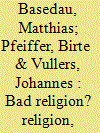

|
|
|
|
|
| Summary/Abstract |
Anecdotal evidence from many armed conflicts suggests that religion incites violence. Theoretically speaking, several facets of religion can create motives and opportunities to overcome the collective action problems associated with organized violence. However, empirical research has hitherto found no conclusive answer on the extent to which religion is connected to armed conflict onset. Contributing to the filling of this gap, we use a new database that incorporates important religious factors that previous studies left largely untested. The data set covers 130 developing countries for the period 1990 to 2010. Results from logistic regressions confirm our expectation that certain religious factors fuel armed conflict—in particular, the overlap of religious and other identities, religious groups’ grievances, and religious leaders’ calls for violence. We also find that religious determinants vary in their impact according to whether conflicts are religious or not in origin.
|
|
|
|
|
|
|
|
|
|
|
|
|
|
|
|
| 2 |
ID:
143343


|
|
|
|
|
| Summary/Abstract |
This article reinvestigates the relationship between real per capita gross domestic product (GDP) and terrorism. We devise a terrorism Lorenz curve to show that domestic and transnational terrorist attacks are each more concentrated in middle-income countries, thereby suggesting a nonlinear income–terrorism relationship. Moreover, this point of concentration shifted to lower income countries after the rising influence of the religious fundamentalist and nationalist/separatist terrorists in the early 1990s. For transnational terrorist attacks, this shift characterized not only the attack venue but also the perpetrators’ nationality. The article then uses nonlinear smooth transition regressions to establish the relationship between real per capita GDP and terrorism for eight alternative terrorism samples, accounting for venue, perpetrators’ nationality, terrorism type, and the period. Our nonlinear estimates are shown to be favored over estimates using linear or quadratic income determinants of terrorism. These nonlinear estimates are robust to additional controls.
|
|
|
|
|
|
|
|
|
|
|
|
|
|
|
|
| 3 |
ID:
143349


|
|
|
|
|
| Summary/Abstract |
Why do some individuals pick up arms as opposed to others who live under the same conditions? Environmental and group theories fail to differentiate between these individuals. In response, we apply the cognitive mapping approach and model violence as decisions based on chains of beliefs about various types of factors, including state aggression, access to violent groups, religion, and personal characteristics. Based on a double-paired comparison, data are constructed from ethnographic interviews with Muslim and non-Muslim individuals engaging in violent and nonviolent activity in authoritarian and democratic states—Egypt and Germany. The analysis develops a computational model formalizing the cognitive maps into Bayesian networks. In 477,604 runs, the model (1) identifies the beliefs connected to decisions, (2) traces inference chains antecedent to decisions, and (3) explores counterfactuals. This suggests that both violent and nonviolent activities are responses to state aggression, and not to Islam, group access, or personal characteristics.
|
|
|
|
|
|
|
|
|
|
|
|
|
|
|
|
| 4 |
ID:
143347
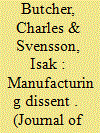

|
|
|
|
|
| Summary/Abstract |
A growing research field examines the conditions under which major nonviolent resistance campaigns—that is, popular nonviolent uprisings for regime or territorial change—are successful. Why these campaigns emerge in the first place is less well understood. We argue that extensive social networks that are economically interdependent with the state make strategic nonviolence more feasible. These networks are larger and more powerful in states whose economies rely upon organized labor. Global quantitative analysis of the onset of violent and nonviolent campaigns from 1960 to 2006 (NAVCO), and major protest events in Africa from 1990 to 2009 (SCAD) shows that the likelihood of nonviolent conflict onset increases with the proportion of manufacturing to gross domestic product. This study points to a link between modernization and social conflict, a link that has been often hypothesized, but, hitherto, unsupported by empirical studies.
|
|
|
|
|
|
|
|
|
|
|
|
|
|
|
|
| 5 |
ID:
143345
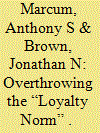

|
|
|
|
|
| Summary/Abstract |
This article examines two competing theories that link variation in the size of a winning coalition to its members’ incentives and ability to orchestrate coups d’état against authoritarian leaders. Selectorate theory’s “loyalty norm” focuses on the incumbent’s ability to buy support and the challenger’s inability to guarantee inclusion in a future coalition. It suggests that, in small-coalition systems, the probability of coup attempts and successes decreases as coalition size decreases. We develop an alternative theory of political accountability that focuses on a coalition’s capacity to coordinate sanctions against a leader. It generates a rival expectation—in small-coalition systems, the probability of coup attempts and successes increases as coalition size decreases. We evaluate these hypotheses through quantitative tests on coup attempts and successes during 1950 to 1999 and with an illustrative case study of the Saint-Sylvestre Coup in the Central African Republic. These analyses provide strong support for our theory of political accountability.
|
|
|
|
|
|
|
|
|
|
|
|
|
|
|
|
| 6 |
ID:
143346
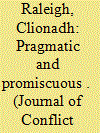

|
|
|
|
|
| Summary/Abstract |
Across African states, militias have become one of the main agents of political violence, accounting for a third of all recent conflict. Militia violence is attributed to cultural reactions to disorder, failing and predatory states, and local cleavages which emerge during civil wars. However, activity largely occurs in democratizing states without civil wars. This article presents a typology of militias based on their local roles and actions and an explanation for the prevalence of “competition militias.” Changes in macro politics ushered in a new era of conflict and fragmentation among political elites; militias operate as private armies for these elites. The goal of this violence is to alter the political landscape, increase power for patrons, protect supportive communities, and hinder opponents. Incentives within African democratic institutions reward the use of force by elites. As a result, African democracies, and states transitioning into democracy, are not likely to be internally peaceful. Futhermore, the dominant type of conflict across African states shifts to accommodate the goals of violent agents within modern political contexts.
|
|
|
|
|
|
|
|
|
|
|
|
|
|
|
|
| 7 |
ID:
143348
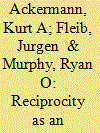

|
|
|
|
|
| Summary/Abstract |
There is accumulating evidence that decision makers (DMs) are sensitive to the distribution of resources among themselves and others, beyond what is expected from the predictions of narrow self-interest. These social preferences are typically conceptualized as being static and existing independently of information about the other people influenced by a DM’s allocation choices. In this article, we consider the reactivity of a DM’s social preferences in response to information about the intentions or past behavior of the person to be affected by the DM’s allocation choices (i.e., how do social preferences change in relation to the other’s type). This article offers a conceptual framework for characterizing the link between distributive preferences and reciprocity, and reports on experiments in which these two constructs are disentangled and the relation between the two is characterized.
|
|
|
|
|
|
|
|
|
|
|
|
|
|
|
|
|
|
|
|
|